Mapping Agricultural Sustainability Through Life Cycle Assessment: A Narrative Review
Abstract
1. Introduction
2. Methodology and Framework
3. Reference Results
3.1. Bibliography Review
3.2. Narrative Review
4. Research Gaps and Proposal for Future Research
- The predominance of static LCA approaches: A significant portion (99%) of the analyzed studies rely on static LCA models, neglecting the inherent dynamism of agricultural systems and the temporal variability of key parameters, such as climate change impacts and evolving agricultural practices.
- Geographical bias: The geographical scope of the existing literature exhibits a marked bias towards European and North American contexts (82% of studies), potentially limiting the applicability of the findings to tropical and African agricultural systems.
- The limited integration of environmental and economic dimensions: Only a minority of studies (26%) integrate both environmental and economic indicators, thereby constraining the ability to formulate holistic policy recommendations.
- The thematic map reveals LCA as a central concept in the assessment of environmental impacts and the promotion of sustainability within the field.
- The analysis of the co-citation network identifies key researchers and influential publications that have shaped the field.
- The network of research collaborations indicates some dispersion between research groups, potentially suggesting specialization within different sub-areas of the field.
5. Conclusions
Author Contributions
Funding
Institutional Review Board Statement
Informed Consent Statement
Data Availability Statement
Conflicts of Interest
References
- PCC. Agriculture. In Climate Change 2007: Mitigation. Contribution of Working Group III to the Fourth Assessment Report of the Intergovernmental Panel on Climate Change; Cambridge University Press: Cambridge, UK, 2007; Chapter 8. [Google Scholar] [CrossRef]
- Alexandratos, N.; Bruinsma, J. World Agriculture Towards 2030/2050: The 2012 Revision; ESA Working Paper No. 12-03; FAO: Rome, Italy, 2012. [Google Scholar] [CrossRef]
- Nsabiyeze, A.; Logossou, K.E.; Ibrahim, H. Tackling climate change in agriculture: A global evaluation of greenhouse gas emissions from agricultural activities. J. Clean. Prod. 2024, 448, 141297. [Google Scholar] [CrossRef]
- Sheridan, C. A critical process analysis of wine production to improve cost, quality and environmental performance. Water Sci. Technol. 2005, 51, 39–46. [Google Scholar] [CrossRef] [PubMed]
- Bastianoni, S.; Capasso, S.; Menna, F. Environmental and economic sustainability. In Wine Safety, Consumer Preference, and Human Health; Morata, A., López, C., Eds.; Academic Press: Cambridge, MA, USA, 2016; pp. 73–83. [Google Scholar]
- Mirzabaev, A.; Bezner Kerr, R.; Hasegawa, T.; Pradhan, P.; Wreford, A.; Cristina Tirado von der Pahlen, M.; Gurney-Smith, H. Severe climate change risks to food security and nutrition. Clim. Risk Manag. 2023, 39, 100473. [Google Scholar] [CrossRef]
- Hasegawa, T.; Fujimori, S.; Shin, Y.; Takahashi, K.; Masui, T.; Tanaka, A. Impacts of land use, population, and climate change on global food security. Food Secur. 2020, 12, 775–790. [Google Scholar] [CrossRef]
- Food and Agriculture Organization of the United Nations. The State of Food and Agriculture 2022: Leveraging Agrifood Systems for a Healthier, More Sustainable Future; FAO: Rome, Italy, 2022; ISBN 978-92-5-136524-5. [Google Scholar]
- Maja, M.M.; Ayano, S.F. The impact of population growth on natural resources and farmers’ capacity to adapt to climate change in low-income countries. Earth Syst. Environ. 2021, 5, 271–283. [Google Scholar] [CrossRef]
- Population Media Center. How Are Population Growth and Climate Change Related? 2023. Available online: https://www.populationmedia.org/the-latest/population-growth-and-climate-change (accessed on 21 May 2025).
- Gomiero, T.; Pimentel, D.; Paoletti, M.G. Is there a need for a more sustainable agriculture? Crit. Rev. Plant Sci. 2011, 30, 6–23. [Google Scholar] [CrossRef]
- Vermeulen, S.J.; Campbell, B.M.; Ingram, J.S. Climate change and food systems. Annu. Rev. Environ. Resour. 2012, 37, 195–222. [Google Scholar] [CrossRef]
- European Environment Agency. Sustainability. European Environment Agency’s Home Page. Available online: https://www.eea.europa.eu/en/topics/at-a-glance/sustainability (accessed on 10 October 2025).
- Menegat, S.; Ledo, A.; Tirado, R. Greenhouse gas emissions from global production and use of nitrogen synthetic fertilizers in agriculture. Sci. Rep. 2022, 12, 14490. [Google Scholar] [CrossRef]
- Bailey, D.; Katz, J.N. Implementing panel-corrected standard errors in R: The pcse package. J. Stat. Softw. 2011, 42, 1–11. [Google Scholar] [CrossRef]
- ISO 14040:2006; Environmental Management—Life Cycle Assessment—Principles and Framework. International Organization for Standardization: Geneva, Switzerland, 2006. Available online: https://www.iso.org/standard/37456.html (accessed on 15 May 2025).
- ISO 14044:2006; Environmental Management—Life Cycle Assessment—Requirements and Guidelines. International Organization for Standardization: Geneva, Switzerland, 2006. Available online: https://www.iso.org/standard/38498.html (accessed on 21 May 2025).
- Jirapornvaree, I.; Suppadit, T.; Kumar, V. Assessing the environmental impacts of agrifood production. Clean Technol. Environ. Policy 2021, 24, 1099–1112. [Google Scholar] [CrossRef]
- Waltman, L.; Calero-Medina, C.; Kosten, J.; Noyons, E.C.M.; Tijssen, R.J.W.; Jan van Eck, N.; van Leeuwen, T.N.; van Raan, A.F.J.; Visser, M.S.; Wouters, P. The Leiden Ranking 2011/2012: Data Collection, Indicators, and Interpretation; CWTS, Leiden University: Leiden, The Netherlands, 2012; Available online: https://arxiv.org/pdf/1202.3941.pdf (accessed on 21 May 2025).
- Higgins, J.P.T.; Green, S. (Eds.) Cochrane Handbook for Systematic Reviews of Interventions; Version 5.1.0; The Cochrane Collaboration: London, UK, 2011; Available online: https://handbook.cochrane.org (accessed on 21 May 2025).
- Zhong, Z. Processes for environmentally friendly and/or cost-effective manufacturing. Mater. Manuf. Process. 2021, 36, 987–1009. [Google Scholar] [CrossRef]
- Caicedo Solano, N.E.; García Llinás, G.A.; Montoya-Torres, J.R. Towards the integration of lean principles and optimization for agricultural production systems: A conceptual review proposition. J. Sci. Food Agric. 2019, 100, 453–464. [Google Scholar] [CrossRef]
- Sieverding, H.; Kebreab, E.; Johnson, J.M.F.; Xu, H.; Wang, M.; Del Grosso, S.J.; Bruggeman, S.; Stewart, C.E.; Westhoff, S.; Ristau, J.; et al. A life cycle analysis (LCA) primer for the agricultural community. Agron. J. 2020, 112, 3788–3807. [Google Scholar] [CrossRef]
- Jaiswal, B.; Agrawal, M. Carbon footprints of agriculture sector. In Environmental Footprints and Eco-design of Products and Processes; Muthu, S.S., Ed.; Springer: Singapore, 2019; pp. 81–99. [Google Scholar] [CrossRef]
- Lu, T.; Halog, A. Towards better life cycle assessment and circular economy: On recent studies on interrelationships among environmental sustainability, food systems and diet. Int. J. Sustain. Dev. World Ecol. 2020, 27, 515–523. [Google Scholar] [CrossRef]
- Venkat, K. Comparison of twelve organic and conventional farming systems: A life cycle greenhouse gas emissions perspective. J. Sustain. Agric. 2012, 36, 620–649. [Google Scholar] [CrossRef]
- Tziolas, E.; Bournaris, T.; Manos, B.; Nastis, S. Life cycle assessment and multi-criteria analysis in agriculture: Synergies and insights. In Multiple Criteria Decision Making; Zopounidis, C., Doumpos, M., Figueira, J., Eds.; Springer: Cham, Switzerland, 2018; pp. 289–321. [Google Scholar] [CrossRef]
- Rocca, P.L. Towards a methodology to consider the environmental impacts of digital agriculture. arXiv 2023, arXiv:2305.09250. [Google Scholar] [CrossRef]
- European Commission. The European Green Deal. In Communication from the Commission to the European Parliament, the European Council, the Council, the European Economic and Social Committee and the Committee of the Regions; COM(2019) 640 Final; European Commission: Brussels, Belgium, 2019; Available online: https://eur-lex.europa.eu/legal-content/EN/TXT/?uri=celex:52022DC0230 (accessed on 21 May 2025).
- European Commission. EU Biodiversity Strategy for 2030: Bringing nature back into our lives. In Communication from the Commission to the European Parliament, the Council, the European Economic and Social Committee and the Committee of the Regions; COM(2020) 380 Final; European Commission: Brussels, Belgium, 2020. [Google Scholar] [CrossRef]
- European Commission. A Farm to Fork Strategy for a fair, healthy and environmentally-friendly food system. In Communication from the Commission to the European Parliament, the Council, the European Economic and Social Committee and the Committee of the Regions; COM(2020) 381 Final; European Commission: Brussels, Belgium, 2020; Available online: https://eur-lex.europa.eu/legal-content/EN/TXT/?uri=celex:52020DC0381 (accessed on 15 May 2025).
- European Parliament and Council. Decision (EU) 2022/591 of the European Parliament and of the Council of 6 April 2022 on a General Union Environment Action Programme to 2030. Off. J. Eur. Union 2022, L 114, 22–36. Available online: https://eur-lex.europa.eu/eli/dec/2022/591/oj/eng (accessed on 15 May 2025).
- European Parliament and Council. Regulation (EU) 2021/2115 of the European Parliament and of the Council of 2 December 2021 establishing rules on support for strategic plans to be drawn up by Member States under the Common agricultural policy. Off. J. Eur. Union 2021, L 435, 1–186. Available online: https://eur-lex.europa.eu/eli/reg/2021/2115/oj/eng (accessed on 15 May 2025).
- United Nations. Transforming Our World: The 2030 Agenda for Sustainable Development; Resolution Adopted by the General Assembly on 25 September 2015, A/RES/70/1; United Nations: New York, NY, USA, 2015. [Google Scholar] [CrossRef]
- Arvanitoyannis, I.S.; Kotsanopoulos, K.V.; Veikou, A. Life cycle assessment (ISO 14040) implementation in foods of animal and plant origin: Review. Crit. Rev. Food Sci. Nutr. 2014, 54, 1253–1282. [Google Scholar] [CrossRef] [PubMed]
- Sugimoto, C.R.; Larivière, V. Measuring Research: What Everyone Needs to Know; Oxford University Press: Oxford, UK, 2024; Available online: https://books.google.com/books/about/Measuring_Research.html?id=O3I8DwAAQBAJ (accessed on 15 May 2025).
- Rousseau, R.; Egghe, L.; Guns, R. Becoming Metric-Wise: A Bibliometric Guide for Researchers; Chandos Publishing: Hull, UK, 2018. [Google Scholar]
- Glä Glänzel, W.; Moed, H.F.; Schmoch, U.; Thelwall, M. (Eds.) Springer Handbook of Science and Technology Indicators; Springer: Cham, Switzerland, 2019. [Google Scholar]
- Donthu, N.; Kumar, S.; Pattnaik, D. Forty-five years of Journal of Business Research: A bibliometric analysis. J. Bus. Res. 2020, 109, 1–14. [Google Scholar] [CrossRef]
- Donthu, N.; Kumar, S.; Pandey, N.; Lim, W.M. Research constituents, intellectual structure, and collaboration patterns in Journal of International Marketing: An analytical retrospective. J. Int. Mark. 2021, 29, 1–25. [Google Scholar] [CrossRef]
- Khan, M.A.; Pattnaik, D.; Ashraf, R.; Ali, I.; Kumar, S.; Donthu, N. Value of special issues in the Journal of Business Research: A bibliometric analysis. J. Bus. Res. 2021, 125, 295–313. [Google Scholar] [CrossRef]
- Linnenluecke, M.K.; Marrone, M.; Singh, A.K. Conducting systematic literature reviews and bibliometric analyses. Aust. J. Manag. 2019, 45, 175–194. [Google Scholar] [CrossRef]
- Haas, G.; Wetterich, F.; Geier, U. Life cycle assessment framework in agriculture on the farm level. Int. J. Life Cycle Assess. 2000, 5, 345–348. [Google Scholar] [CrossRef]
- Habersatter, K. Ökobilanz von Packstoffen—Stand 1990; Schriftenreihe Umwelt; BUWAL: Bern, Switzerland, 1991; 263p. [Google Scholar]
- Heijungs, R.; Guinée, J.B.; Huppes, G.; Langreijer, R.M.; de Haes, H.A.U.; Sleeswijk, A.W. Environmental Life Cycle Assessment of Products—Backgrounds 9267; CML: Leiden, The Netherlands, 1992; 130p. [Google Scholar]
- Audsley, E. Harmonisation of Environmental Life Cycle Assessment for Agriculture; Final Report, Concerted Action AIR3-CT94-2028; European Commission, DG VI Agriculture: Brussels, Belgium, 1997; p. 139. [Google Scholar]
- FAL. Ökobilanzen—Beitrag zu einer nachhaltigen Landwirtschaft; Schriftenreihe FAL: Zürich, Switzerland, 2002; 37p. [Google Scholar]
- Gaillard, G.; Nemecek, T. Swiss agricultural life cycle assessment (SALCA): An integrated environmental assessment concept for agriculture. In Proceedings of the International Conference “Integrated Assessment of Agriculture and Sustainable Development”, Egmont aan Zee, The Netherlands, 10–12 March 2009; AgSAP Office, Wageningen University: Wageningen, The Netherlands, 2009; pp. 134–135. [Google Scholar]
- Sleeswijk, A.W.; Meussen, M.J.G.; van Zeijts, H.; Kleijn, R.; Leneman, H.; Reus, J.; Sengers, H. Application of LCA to Agricultural Products; CML: Leiden, The Netherlands, 1996; 106p. [Google Scholar]
- Moutik, B.; Summerscales, J.; Graham-Jones, J.; Pemberton, R. Life cycle assessment research trends and implications: A bibliometric analysis. Sustainability 2023, 15, 13408. [Google Scholar] [CrossRef]
- Goedkoop, M.; Spriensma, R. The Eco-Indicator 99: A Damage Oriented Method for Life Cycle Impact Assessment, Methodology Report, 3rd ed.; PRé Consultants: Amersfoort, The Netherlands, 2001; Available online: https://www.researchgate.net/publication/247848113 (accessed on 6 June 2025).
- Jolliet, O.; Margni, M.; Charles, R.; Humbert, S.; Payet, J.; Rebitzer, G.; Rosenbaum, R. IMPACT 2002+: A new life cycle impact assessment methodology. Int. J. Life Cycle Assess. 2003, 8, 324–330. [Google Scholar] [CrossRef]
- Guinée, J.B. Handbook on life cycle assessment: Operational guide to the ISO standards. Int. J. Life Cycle Assess. 2002, 7, 311–313. [Google Scholar] [CrossRef]
- Finnveden, G.; Hauschild, M.; Ekvall, T.; Guinée, J.; Heijungs, R.; Hellweg, S.; Koehler, A.; Pennington, D.; Suh, S. Recent developments in life cycle assessment. J. Environ. Manag. 2009, 91, 1–21. [Google Scholar] [CrossRef]
- Potting, J.; Hauschild, M.Z. Background for spatial differentiation in life cycle impact assessment. In The EDIP2003 Methodology; DTU Library: Kongens Lyngby, Denmark, 2004. [Google Scholar]
- Binnemans, K.; Jones, P.T.; Blanpain, B.; Van Gerven, T.; Yang, Y.; Walton, A.; Buchert, M. Recycling of rare earths: A critical review. J. Clean Prod. 2013, 51, 1–22. [Google Scholar] [CrossRef]
- Levasseur, A.; Lesage, P.; Margni, M.; Deschênes, L.; Samson, R. Considering time in LCA: Dynamic LCA and its application to global warming impact assessments. Environ. Sci. Technol. 2010, 44, 3169–3174. [Google Scholar] [CrossRef]
- Hendrickson, C.; Horvath, A.; Joshi, S.; Lave, L. Economic input-output models for environmental life-cycle assessment. Environ. Sci. Technol. 1998, 32, 184A–191A. [Google Scholar] [CrossRef]
- Ellegaard, O.; Wallin, J.A. The bibliometric analysis of scholarly production: How great is the impact? Scientometrics 2015, 105, 1809–1831. [Google Scholar] [CrossRef]
- Pritchard, A. Statistical bibliography or bibliometrics. J. Doc. 1969, 25, 348. [Google Scholar]
- Carpenter, C.R.; Cone, D.C.; Sarli, C.C. Using publication metrics to highlight academic productivity and research impact. Acad. Emerg. Med. 2014, 21, 1160–1172. [Google Scholar] [CrossRef]
- Durieux, V.; Gevenois, P.A. Bibliometric Indicators: Quality Measurements of Scientific Publication. Radiology 2010, 255, 342–351. [Google Scholar] [CrossRef] [PubMed]
- Rowley, J.; Slack, F. Conducting a literature review. Manag. Res. News 2004, 27, 31–39. [Google Scholar] [CrossRef]
- Aria, M.; Cuccurullo, C. Bibliometrix: An R-tool for comprehensive science mapping analysis. J. Informetr. 2017, 11, 959–975. [Google Scholar] [CrossRef]
- Zachos, G. Research output evaluation of two university departments in Greece with the use of bibliometric indicators. Scientometrics 1991, 21, 195–221. [Google Scholar] [CrossRef]
- Hirsch, J.E. An index to quantify an individual’s scientific research output. Proc. Natl. Acad. Sci. USA 2005, 102, 16569–16572. [Google Scholar] [CrossRef] [PubMed]
- Bornmann, L.; Daniel, H.D. What do we know about the h-index? J. Am. Soc. Inf. Sci. Technol. 2007, 58, 1381–1385. [Google Scholar] [CrossRef]
- Suzuki, H. Google Scholar Metrics for Publications. 2012. Available online: https://googlescholar.blogspot.com.br (accessed on 15 May 2025).
- Jones, T.; Huggett, S.; Kamalski, J. Finding a way through the scientific literature: Indexes and measures. World Neurosurg. 2011, 76, 36–38. [Google Scholar] [CrossRef]
- Egghe, L. Theory and practise of the g-index. Scientometrics 2006, 69, 131–152. [Google Scholar] [CrossRef]
- Biradar, N.; Kumbar, P. A comparative study: Application of Bradford’s law of scattering to the epidemiology literature of India and Japan. Res. J. Libr. Inf. Sci. 2020, 4, 7–16. [Google Scholar] [CrossRef]
- Bradford, S.C. Sources of information on specific subjects. Eng. Illus. Wkly. J. 1934, 10, 85–86. [Google Scholar]
- Bradford, S.C. Specific subjects. J. Inf. Sci. 1985, 10, 173–180. [Google Scholar]
- Zupic, I.; Cater, T. Bibliometric methods in management and organization. Organ. Res. Methods 2015, 18, 429–472. [Google Scholar] [CrossRef]
- Nemecek, T.; Dubois, D.; Huguenin-Elie, O.; Gaillard, G.; Schaller, B.; Chervet, A. Life cycle assessment of Swiss farming systems: I. Integrated and organic farming. Agric. Syst. 2011, 104, 217–232. [Google Scholar] [CrossRef]
- Bacenetti, J.; Fiala, M.; Gallo, V. Environmental, economic and social sustainability assessment of precision agriculture: A case study on apple production. Sustainability 2019, 11, 2078. [Google Scholar] [CrossRef]
- Rieradevall, J.; Gabarrell, X.; Anton, A. Integrating sustainability policies in farm-level decision-making processes: A comprehensive review. J. Clean. Prod. 2020, 259, 120835. [Google Scholar] [CrossRef]
- Wee, B.V.; Banister, D. How to write a literature review paper? Transp. Rev. 2016, 36, 278–288. [Google Scholar] [CrossRef]
- Symeonaki, E.G.; Arvanitis, K.G.; Piromalis, D.D. Current trends and challenges in the deployment of IoT technologies for climate smart facility agriculture. Int. J. Sustain. Agric. Manag. Inform. 2019, 5, 181. [Google Scholar] [CrossRef]
- Hou, Q.; Mao, G.; Zhao, L.; Zuo, J. Mapping the scientific research on life cycle assessment: A bibliometric analysis. Int. J. Life Cycle Assess. 2015, 20, 541–555. [Google Scholar] [CrossRef]
- Notarnicola, B.; Tassielli, G.; Renzulli, P.A.; Castellani, V.; Sala, S. Environmental impacts of food consumption in Europe. J. Clean. Prod. 2017, 140, 753–765. [Google Scholar] [CrossRef]
- Rebitzer, G.; Ekvall, T.; Frischknecht, R.; Hunkeler, D.; Norris, G.; Rydberg, T.; Schmidt, W.P.; Suh, S.; Weidema, B.P.; Pennington, D.W. Life cycle assessment part 1: Framework, goal and scope definition, inventory analysis, and applications. Environ. Int. 2004, 30, 701–720. [Google Scholar] [CrossRef] [PubMed]
- Shahzad, A.; Ullah, S.; Dar, A.A.; Sardar, M.F.; Mehmood, T.; Tufail, M.A.; Shakoor, A.; Haris, M. Nexus on climate change: Agriculture and possible solution to cope future climate change stresses. Environ. Sci. Pollut. Res. 2021, 28, 14211–14232. [Google Scholar] [CrossRef] [PubMed]
- Antón, A.; Torrellas, M.; Núñez, M.; Sevigné, E.; Amores, M.J.; Muñoz, P.; Montero, J.I. Improvement of agricultural life cycle assessment studies through spatial differentiation and new impact categories: Case study on greenhouse tomato production. Environ. Sci. Technol. 2014, 48, 9454–9462. [Google Scholar] [CrossRef] [PubMed]
- Dawson, N.; Martin, A.; Camfield, L. Can agricultural intensification help attain Sustainable Development Goals? Evidence from Africa and Asia. Third World Q. 2019, 40, 926–946. [Google Scholar] [CrossRef]
- Whitelock, V.G. Multidimensional environmental social governance sustainability framework: Integration, using a purchasing, operations, and supply chain management context. Sustain. Dev. 2019, 27, 923–931. [Google Scholar] [CrossRef]
- Hietala, M.; Geysmans, R. Social sciences and radioactive waste management: Acceptance, acceptability, and a persisting socio-technical divide. J. Risk Res. 2020, 25, 423–438. [Google Scholar] [CrossRef]
- Anderson, S.C.; Elsen, P.R.; Hughes, B.B.; Tonietto, R.K.; Bletz, M.C.; Gill, D.A.; Holgerson, M.A.; Kuebbing, S.E.; MacKenzie, C.M.; Meek, M.H.; et al. Trends in ecology and conservation over eight decades. Front. Ecol. Environ. 2021, 19, 274–282. [Google Scholar] [CrossRef]
- Streimikis, J.; Baležentis, T. Agricultural sustainability assessment framework integrating sustainable development goals and interlinked priorities of environmental, climate and agriculture policies. Sustain. Dev. 2020, 28, 1702–1712. [Google Scholar] [CrossRef]
- Sarkar, A.; Wang, H.; Rahman, A.; Memon, W.H.; Qian, L. A bibliometric analysis of sustainable agriculture: Based on the Web of Science (WOS) platform. Environ. Sci. Pollut. Res. 2022, 29, 38928–38949. [Google Scholar] [CrossRef]
- Pelletier, N.; Arsenault, N.; Tyedmers, P. Scenario-modeling potential eco-efficiency gains from a transition to organic agriculture: Life cycle perspectives on Canadian canola, corn, soy and wheat production. Environ. Manag. 2008, 42, 989–1001. [Google Scholar] [CrossRef] [PubMed]
- Smith, P.; Reay, D.; Smith, J. Agricultural methane emissions and the potential formitigation. Philos. Trans. R. Soc. A Math. Phys. Eng. Sci. 2021, 379, 20200451. [Google Scholar] [CrossRef] [PubMed]
- Shubbar, H.T.; Tahir, F.; Al-Ansari, T. Bridging Qatar’s food demand and self-sufficiency. Sci. Total Environ. 2024, 957, 167436. [Google Scholar] [CrossRef]
- Mialyk, O.; Schyns, J.F.; Booij, M.J.; Su, H.; Hogeboom, R.J.; Berger, M. Water footprints and crop water use of 175 individual crops at a 5 arcminute resolution over the 1990–2019 period. Sci. Data 2024, 11, 11370. [Google Scholar] [CrossRef]
- Valdivia, S.; Backes, J.G.; Traverso, M.; Sonnemann, G.; Cucurachi, S.; Guinée, J.B.; Schaubroeck, T.; Finkbeiner, M.; Leroy-Parmentier, N.; Ugaya, C.; et al. Principles for the application of life cycle sustainability assessment. Int. J. Life Cycle Assess. 2021, 26, 1900–1905. [Google Scholar] [CrossRef]
- Su, S.; Li, X.; Hao, Y.; Shao, Q. A Comprehensive Dynamic Life Cycle Assessment Model and Its Application. Sustainability 2022, 14, 13628. [Google Scholar] [CrossRef]
- Lan, K.; Kelley, S.S.; Nepal, P.; White, E. Integrating Life Cycle Assessment and Agent-Based Modeling: A Dynamic Modeling Framework for Sustainable Agricultural Systems. J. Clean. Prod. 2019, 238, 117853. [Google Scholar] [CrossRef]
- Lopez-Ridaura, S.; Masera, O.; Astier, M. Coupling dynamic simulation models with Life Cycle Assessment: A case study of dairy farming systems. Agric. Syst. 2008, 96, 105–114. Available online: https://agritrop.cirad.fr/547188/1/document_547188.pdf (accessed on 15 May 2025).
- Jain, C.K.; Singh, S. Best management practices for agricultural nonpoint source pollution: Policy interventions and way forward. World Water Policy 2019, 5, 207–228. [Google Scholar] [CrossRef]
- Gómez, J.; Rodríguez-Carretero, M.T.; Lorite, I.J.; Fereres, E. Modeling to evaluate and manage climate change effects on water use in Mediterranean olive orchards with respect to cover crops and tillage management. Adv. Agric. Syst. Model. 2015, 5, 237–265. [Google Scholar] [CrossRef]
- Gabaldón-Leal, C.; Ruiz-Ramos, M.; De la Rosa, R.; León, L.; Belaj, A.; Rodríguez, A.; Santos, C.; Lorite, I.J. Impact of changes in mean and extreme temperatures caused by climate change on olive flowering in southern Spain. Int. J. Climatol. 2017, 37, S940–S957. [Google Scholar] [CrossRef]
- Boitshwarelo, B.; Reedy, A.K.; Billany, T. Envisioning the use of online tests in assessing twenty-first century learning: A literature review. Res. Pract. Technol. Enhanc. Learn. 2017, 12, 1. [Google Scholar] [CrossRef]
- Reynolds, T.W.; Waddington, S.R.; Anderson, C.L.; Chew, A.; True, Z.; Cullen, A. Environmental impacts and constraints associated with the production of major food crops in Sub-Saharan Africa and South Asia. Food Secur. 2015, 7, 795–822. [Google Scholar] [CrossRef]
- Sala, S.; Amadei, A.M.; Beylot, A.; Ardente, F. The evolution of life cycle assessment in European policies over three decades. Int. J. Life Cycle Assess. 2021, 26, 2295–2314. [Google Scholar] [CrossRef]
- Schoolman, E.D.; Guest, J.S.; Bush, K.F.; Bell, A.R. How interdisciplinary is sustainability research? Analyzing the structure of an emerging scientific field. Sustain. Sci. 2011, 7, 67–80. [Google Scholar] [CrossRef]
- Yang, Y.; Pelton, R.E.O.; Kim, T.; Smith, T.M. Effects of spatial scale on life cycle inventory results. Environ. Sci. Technol. 2019, 54, 1293–1303. [Google Scholar] [CrossRef] [PubMed]
- BjØrn, A.; Chandrakumar, C.; Boulay, A.-M.; Doka, G.; Fang, K.; Gondran, N.; Hauschild, M.Z.; Kerkhof, A.; King, H.; Margni, M.; et al. Review of life-cycle based methods for absolute environmental sustainability assessment and their applications. Environ. Res. Lett. 2020, 15, 083001. [Google Scholar] [CrossRef]
- Gustafson, D.; Asseng, S.; Fraisse, C.; Guan, K.; Hoogenboom, G.; Kruger, C.; Kruse, J.; Matlock, M.; Melnick, R.; Parajuli, R.; et al. In pursuit of more fruitful food systems. Int. J. Life Cycle Assess. 2022, 27, 1267–1269. [Google Scholar] [CrossRef]

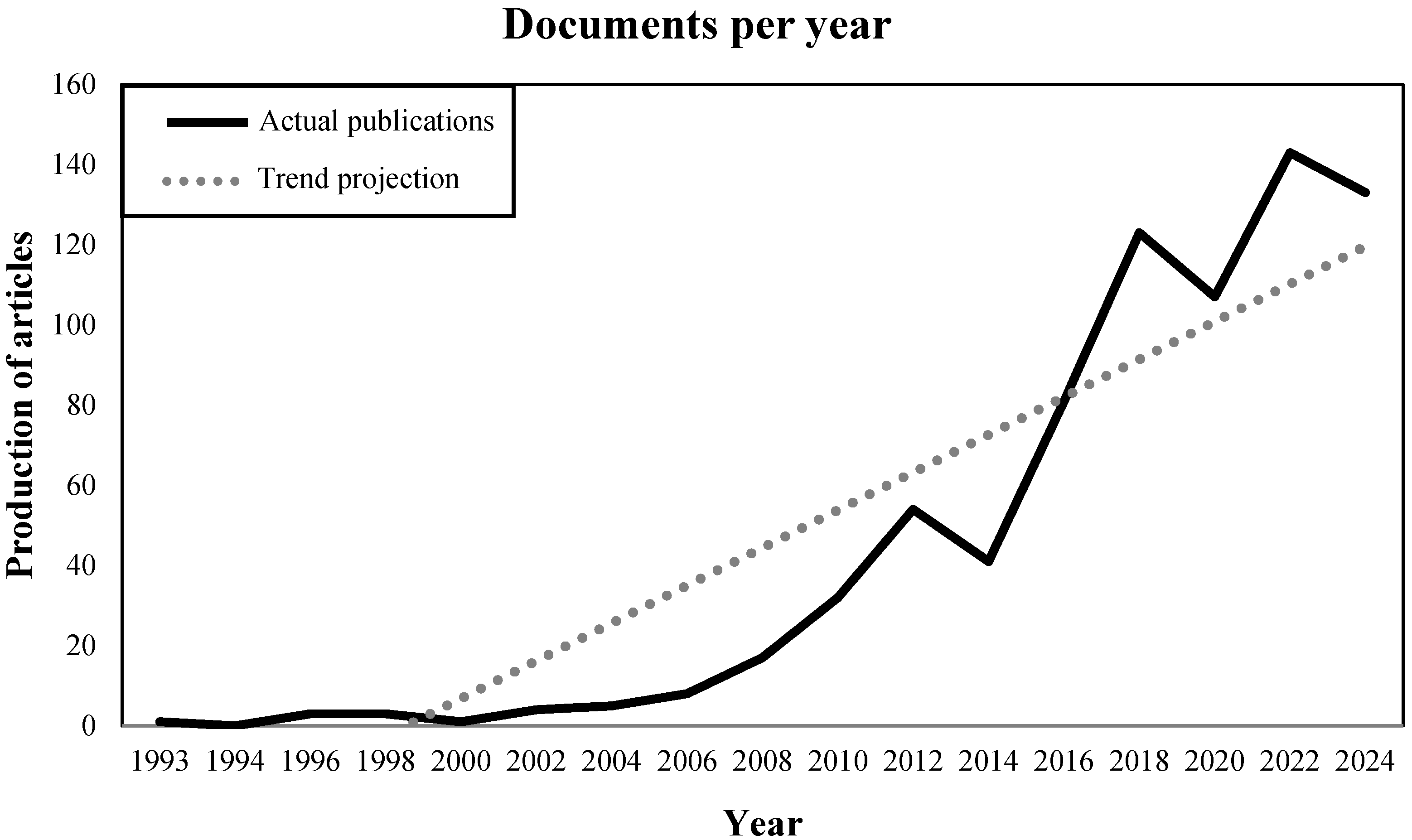
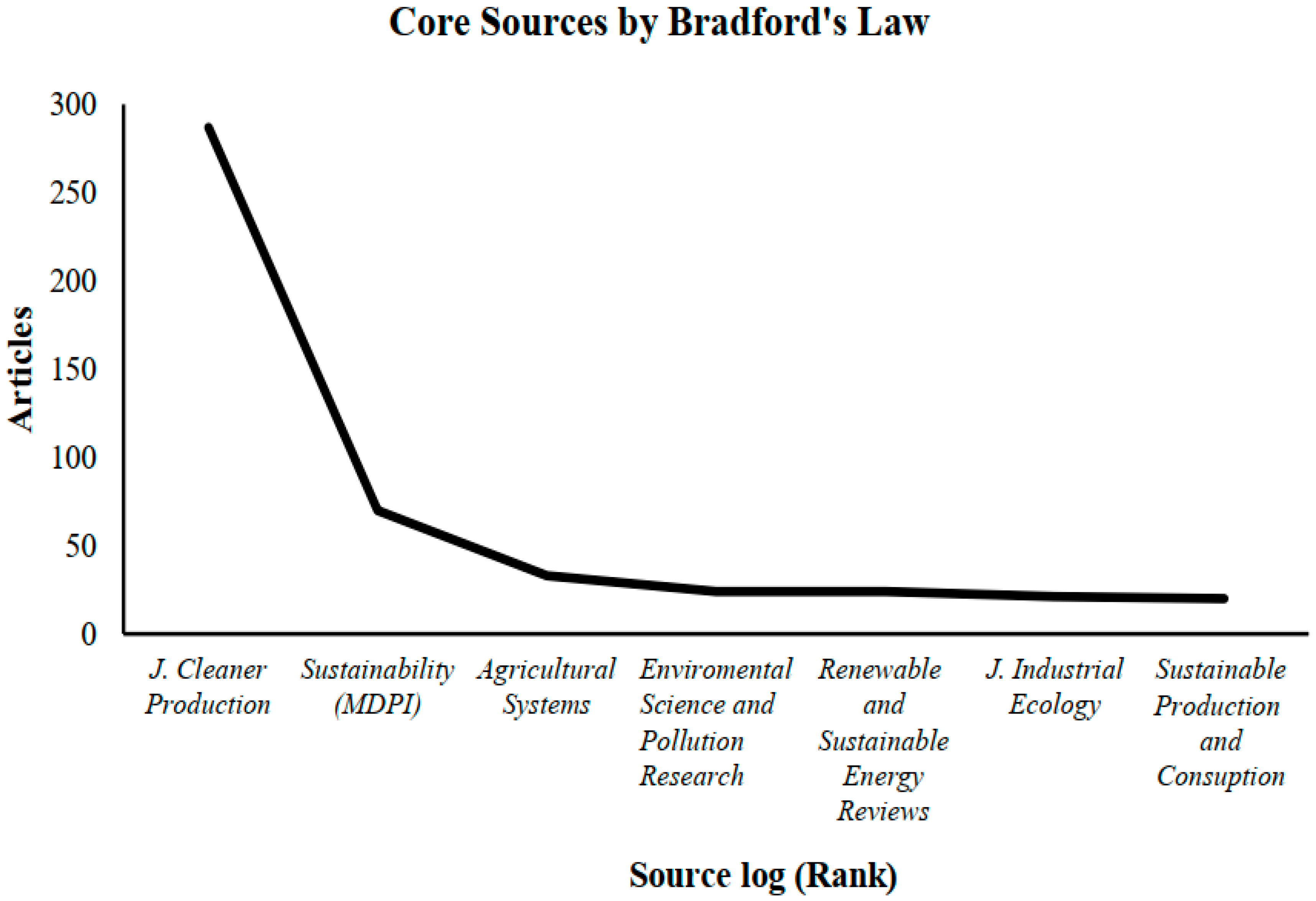
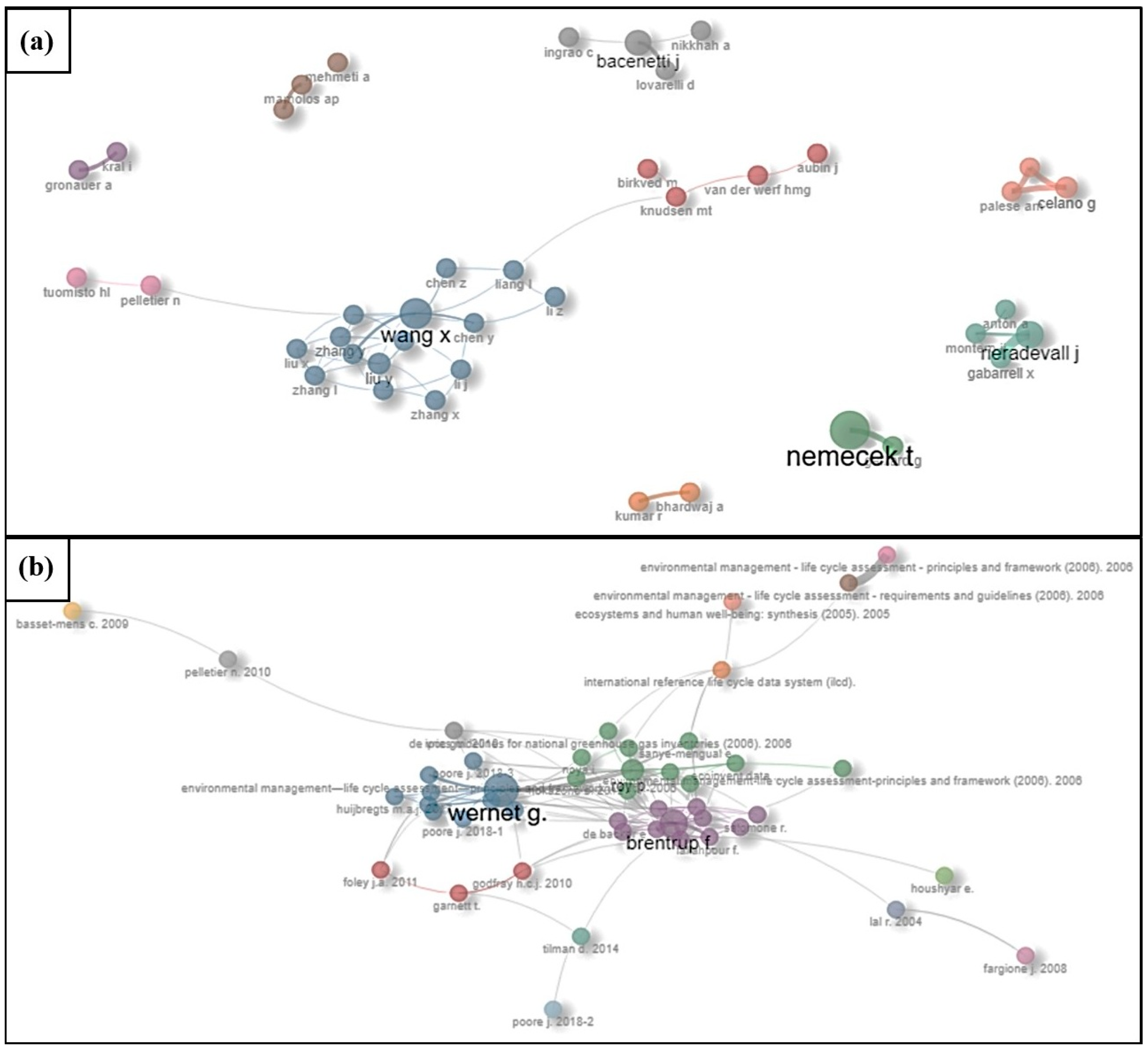
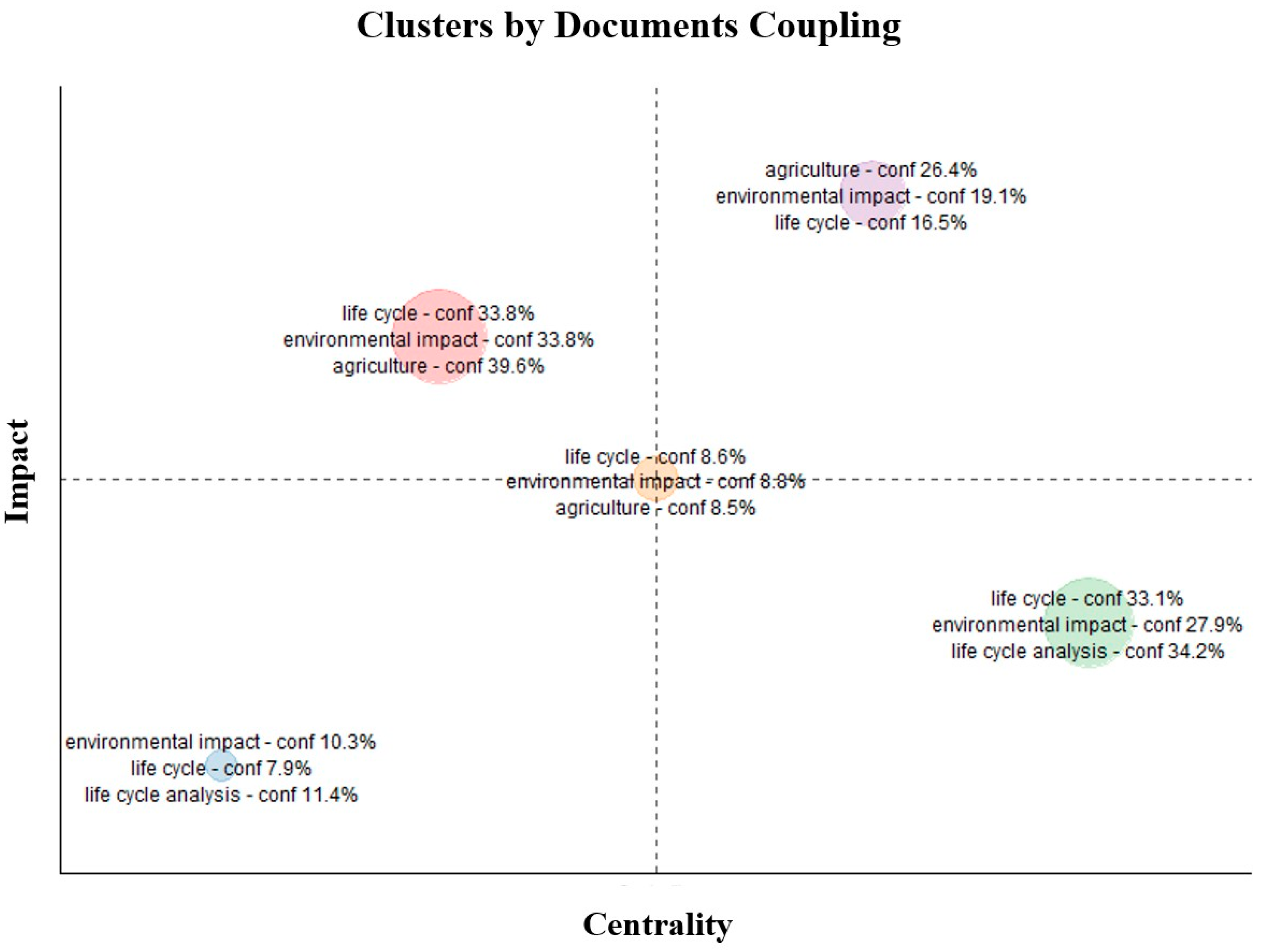



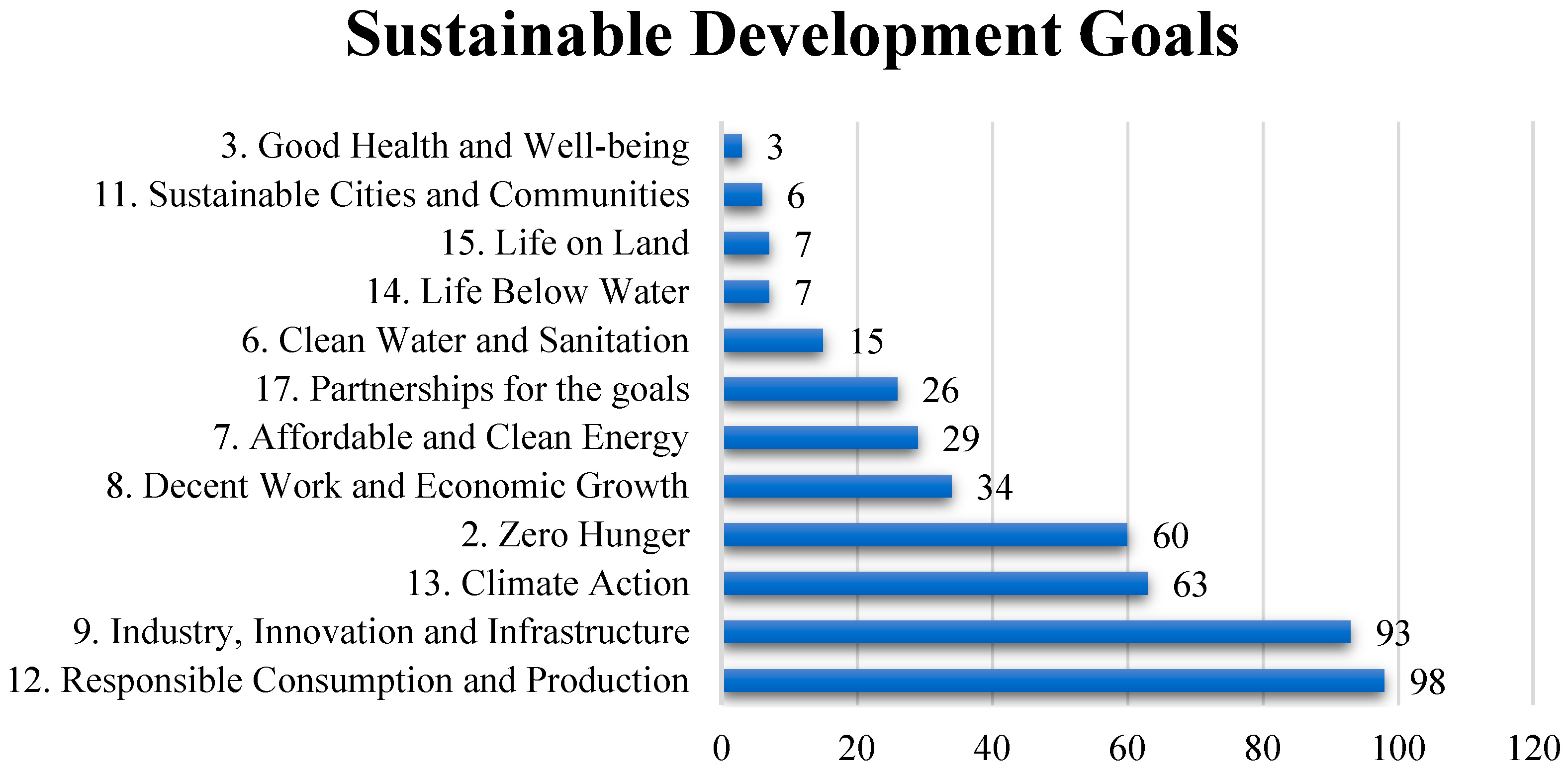
| Author | h-Index | g-Index | m-Index | TC | NP | PY Start |
|---|---|---|---|---|---|---|
| Nemecek T | 17 | 22 | 0.8947368 | 1613 | 22 | 2006 |
| Bacenetti JJ | 10 | 13 | 0.9090909 | 513 | 13 | 2014 |
| Rieravevall J | 10 | 11 | 0.6666666 | 755 | 11 | 2010 |
| Van der Werf HMG | 10 | 11 | 0.5 | 1205 | 11 | 2005 |
| Wang X | 10 | 13 | 0.7692307 | 386 | 13 | 2012 |
| Gaillard G | 9 | 10 | 0.4736842 | 913 | 10 | 2006 |
| Nabavi—Pelesaraei A | 8 | 8 | 1 | 646 | 8 | 2017 |
| Gabarrell X | 7 | 8 | 0.4666666 | 484 | 8 | 2010 |
| Zhang Y | 7 | 9 | 0.4375 | 243 | 9 | 2009 |
| Aubin J | 6 | 6 | 0.375 | 351 | 6 | 2009 |
| Source | Rank | Freq | cumFreq |
|---|---|---|---|
| Journal of Cleaner Production | 1 | 287 | 287 |
| Sustainability (Switzerland) | 2 | 70 | 357 |
| Agricultural Systems | 3 | 33 | 390 |
| Environmental Science and Pollution Research | 4 | 24 | 414 |
| Renewable and Sustainable Energy Reviews | 5 | 24 | 438 |
| Journal of Industrial Ecology | 6 | 21 | 459 |
| Sustainable Production and Consumption | 7 | 20 | 479 |
| Label | Group | Freq | Centrality | Impact |
|---|---|---|---|---|
| Environmental impact—conf 21.9% Life cycle—conf 14.6% Agriculture—conf 13.3% | 1 | 27 | 0.54298317 | 4.72050265 |
| Life cycle—conf 29.3% Agriculture—conf 26.7% Environmental impact—conf 21.9% | 3 | 18 | 0.52981857 | 1.84077243 |
| Life cycle—conf 56.1% Agriculture—conf 60% Environmental impact—conf 56.2% | 5 | 48 | 1.43121433 | 1.66410422 |
| Source | Publications |
|---|---|
| Journal of Cleaner Production | 31 |
| Sustainability (Switzerland) | 6 |
| Sustainable Production and Consumption | 5 |
| Agricultural Systems | 4 |
| Environmental Impact Assessment Review | 3 |
Disclaimer/Publisher’s Note: The statements, opinions and data contained in all publications are solely those of the individual author(s) and contributor(s) and not of MDPI and/or the editor(s). MDPI and/or the editor(s) disclaim responsibility for any injury to people or property resulting from any ideas, methods, instructions or products referred to in the content. |
© 2025 by the authors. Licensee MDPI, Basel, Switzerland. This article is an open access article distributed under the terms and conditions of the Creative Commons Attribution (CC BY) license (https://creativecommons.org/licenses/by/4.0/).
Share and Cite
Spanos, K.; Kladovasilakis, N.; Achillas, C.; Aidonis, D. Mapping Agricultural Sustainability Through Life Cycle Assessment: A Narrative Review. Environments 2025, 12, 436. https://doi.org/10.3390/environments12110436
Spanos K, Kladovasilakis N, Achillas C, Aidonis D. Mapping Agricultural Sustainability Through Life Cycle Assessment: A Narrative Review. Environments. 2025; 12(11):436. https://doi.org/10.3390/environments12110436
Chicago/Turabian StyleSpanos, Konstantinos, Nikolaos Kladovasilakis, Charisios Achillas, and Dimitrios Aidonis. 2025. "Mapping Agricultural Sustainability Through Life Cycle Assessment: A Narrative Review" Environments 12, no. 11: 436. https://doi.org/10.3390/environments12110436
APA StyleSpanos, K., Kladovasilakis, N., Achillas, C., & Aidonis, D. (2025). Mapping Agricultural Sustainability Through Life Cycle Assessment: A Narrative Review. Environments, 12(11), 436. https://doi.org/10.3390/environments12110436








